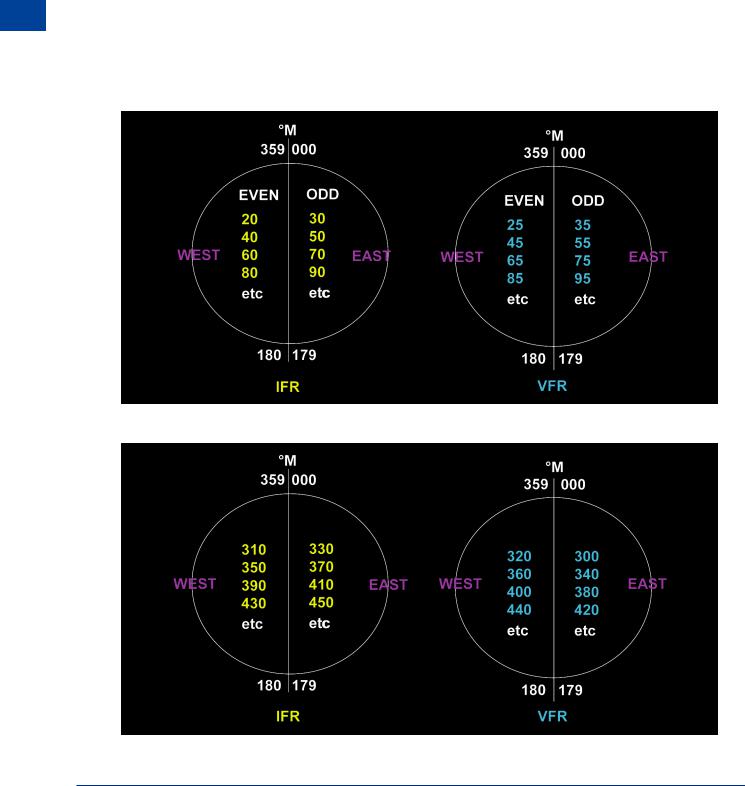
- •Textbook Series
- •Contents
- •1 Definitions
- •Introduction
- •Abbreviations
- •Definitions
- •2 International Agreements and Organizations
- •The Chicago Convention
- •International Law
- •Commercial Considerations
- •Customs and Excise, and Immigration
- •International Obligations of Contracted States
- •Duties of ICAO Member States
- •Status of Annex Components
- •The International Civil Aviation Organization (ICAO)
- •The Organization of ICAO
- •Regional Structure of ICAO
- •Regional Structure and Offices
- •ICAO Publications
- •Other International Agreements
- •The Conventions of Tokyo, the Hague and Montreal
- •The Warsaw Convention
- •The Rome Convention
- •IATA
- •ECAC
- •EASA
- •Eurocontrol
- •World Trade Organization
- •Geneva Convention
- •EU Regulation 261/2004
- •Questions
- •Answers
- •3 Airworthiness of Aircraft
- •Introduction
- •Airworthiness
- •Questions
- •Answers
- •4 Aircraft Nationality and Registration Marks
- •Introduction
- •Nationality and Registration Marks
- •Certification of Registration
- •Aircraft Markings
- •Classification of Aircraft
- •Questions
- •Answers
- •5 Flight Crew Licensing
- •Introduction
- •Definitions
- •General Rules Concerning Licensing
- •Licences and Ratings for Pilots
- •Multi-crew Pilot Licence (MPL)
- •Instrument Rating (Aeroplane) (IR(A))
- •Instructor and Examiner Rating
- •JAR-FCL 3 Medical Requirements
- •Pilot Proficiency
- •EASA Theoretical Knowledge Examinations
- •Questions
- •Answers
- •6 Rules of the Air
- •History
- •Applicability of the Rules of the Air
- •General Rules
- •Visual Flight Rules
- •Instrument Flight Rules
- •Semi-circular Flight Level Rules and RVSM
- •Special VFR
- •Distress and Urgency Signals
- •Restricted, Prohibited or Danger Areas
- •Signals for Aerodrome Traffic
- •Marshalling Signals
- •Flight Deck Signals
- •Questions
- •Answers
- •Instrument Procedures
- •PANS OPS
- •Instrument Departure Procedures
- •Questions
- •Answers
- •8 Approach Procedures
- •Procedure Basics
- •Approach Procedure Design
- •Obstacle Clearance Altitude/Height
- •Operating Minima
- •Descent Gradients
- •Track Reversal and Racetracks
- •Missed Approach Segment and Procedure
- •Published Information
- •RNAV Approach Procedures based on VOR/DME
- •Questions
- •Answers
- •9 Circling Approach
- •Circling Approach
- •Questions
- •Answers
- •10 Holding Procedures
- •Holding Procedures
- •Entry Sectors
- •ATC Considerations
- •Obstacle Clearance
- •Questions
- •Answers
- •11 Altimeter Setting Procedure
- •Altimeter Setting Objectives
- •Transition
- •Phases of Flight
- •Questions
- •Answers
- •12 Parallel or Near-parallel Runway Operation
- •Safety
- •Runway Spacing
- •Questions
- •Answers
- •13 SSR and ACAS
- •Airborne Collision Avoidance System (ACAS)
- •Questions
- •Answers
- •14 Airspace
- •Introduction
- •Control Areas and Zones
- •Classes of Airspace
- •Required Navigation Performance (RNP)
- •Airways and ATS Routes
- •Questions
- •Answers
- •15 Air Traffic Services
- •Introduction
- •Air Traffic Control
- •ATC Clearances
- •Control of Persons and Vehicles at Aerodromes
- •The Flight Information Service
- •The Alerting Service
- •Procedures
- •Questions
- •Answers
- •16 Separation
- •Concept of Separation
- •Vertical Separation
- •Horizontal Separation
- •Radar Separation
- •Procedural Wake Turbulence Separation
- •Radar Wake Turbulence Separation
- •Visual Separation in the Vicinity of Aerodromes
- •Stacking
- •Questions
- •Answers
- •17 Control of Aircraft
- •Procedural ATC
- •Radar Control
- •Radar Identification
- •Radar Service
- •Aerodrome Control
- •Approach Control Service
- •Air Traffic Advisory Service
- •Aircraft Emergencies
- •Questions
- •Answers
- •18 Aeronautical Information Service (AIS)
- •Introduction
- •General
- •The Integrated Aeronautical Information Package
- •The Aeronautical Information Publication (AIP)
- •Notices to Airmen (NOTAM)
- •SNOWTAM
- •ASHTAM
- •Aeronautical Information Circulars (AICs)
- •Pre-flight and Post-flight Information
- •Questions
- •Answers
- •Introduction
- •Aerodrome Reference Code
- •Glossary of Terms
- •Aerodrome Data
- •Runways
- •Taxiways
- •Aprons
- •Questions
- •Answers
- •Requirements
- •Visual Aids for Navigation
- •Runway Markings
- •Taxiway Markings
- •Signs
- •Markers
- •Visual Docking Guidance Systems
- •Questions
- •Answers
- •21 Aerodrome Lighting
- •Aerodrome Lights
- •Approach Lighting Systems
- •Runway Lighting
- •Taxiway Lighting
- •Questions
- •Answers
- •22 Obstacle Marking and Aerodrome Services
- •Introduction
- •Visual Aids for Denoting Obstacles
- •Visual Aids for Denoting Restricted Use Areas
- •Emergency and Other Services
- •Other Aerodrome Services
- •Questions
- •Answers
- •23 Facilitation
- •Entry and Departure of Aircraft
- •Questions
- •Answers
- •24 Search and Rescue
- •Definitions and Abbreviations
- •Establishment and Provision of SAR Service
- •Co-operation between States
- •Operating Procedures
- •Questions
- •Answers
- •25 Security
- •Introduction
- •Objectives
- •Organization
- •Preventative Security Measures
- •Management of Response to Acts of Unlawful Interference
- •Further Security Information
- •Questions
- •Answers
- •26 Aircraft Accident and Incident Investigation
- •Introduction
- •Objective of Investigation
- •Investigations
- •Serious Incidents
- •EU Considerations
- •Questions
- •Answers
- •27 Revision Questions
- •Revision Questions
- •Answers
- •EASA Specimen Examination
- •Answers to Specimen EASA Examination
- •28 Addendum – EASA Part-FCL & Part-MED
- •Chapter Five. Flight Crew Licensing
- •European Aviation Safety Agency (EASA)
- •Licences
- •Ratings
- •Certificates
- •EASA Part-MED
- •29 Index

Rules of the Air |
|
6 |
|
||
|
|
|
Visual Flight Rules
6.59 Visual Meteorological Conditions (VMC). With the exception of special VFR (SVFR - see paragraph 6.77), VFR is only permitted in VMC (see 6.5). If a flight is operated under VFR and the meteorological conditions deteriorate such that it becomes impossible to continue in VMC the pilot must either:
•Land whilst able to maintain flight in VMC; or
•Change the route of the flight to maintain flight in VMC; or
•File an IFR flight plan and continue under IFR; or
•If within a CTR, request a SVFR clearance.
6.60 Take-off/Landing Conditions. Unless authorized by ATC, VFR flights are not to take off or land at an aerodrome in a CTR, or enter the ATZ or traffic pattern:
•When the cloud ceiling (see definition) is less than 450 m (1500 ft) or
•When ground visibility (see definition) is less than 5 km
6.61 Prohibition of VFR flight. Between sunset and sunrise, or during any other period as may be specified by the ATS authority, VFR flights are to be operated in accordance with the conditions required by such authority.
•VFR flights require an ATC clearance to operate:
•Above FL200.
•At transonic or supersonic speeds.
•VFR flight is not permitted above FL285 where RVSM is applied.
•Except when taking off and landing (or when specially approved by the authority e.g. air displays etc…), VFR flight is not allowed:
•Over the congested areas of cities, towns or settlements, or over an open air assembly of persons, at a height less than 300 m (1000 ft) above the highest obstacle within a radius of 600 m from the aircraft.
•At a height not less than 150 m (500 ft) above the surface (ground or water).
6.62 VFR Flight Levels. In level cruising flight above the transition altitude (normally 3000 ft AGL), VFR flight is to be conducted at a VFR flight level appropriate to the magnetic track of the aircraft in accordance with the semi-circular rule defined in paragraph 6.74. When operating as a controlled VFR flight within controlled airspace (CAS), the FL or altitude will be specified by ATC in the ATC clearance for that flight. VFR flights are to comply with ATC instructions:
•When operating in class B, C or D airspace (in class A, VFR flight is not permitted)
•When forming part of aerodrome traffic at controlled aerodromes, or
•When operating as special VFR flights
Rules of the Air 6
117

6 |
|
Rules of the Air |
|
||
|
|
|
Air the of Rules 6
6.63 VFR Flight Plan. A VFR flight plan is to be filed before operating a VFR flight as a controlled flight. To indicate that the flight will be operated under VFR, the letter “V” is placed in item 8 of the flight plan form. If a flight is to commence under VFR and at some point en route change to IFR, the letter “Z” is placed in field 8 (V → I = Z). Where the PIC of a VFR flight wishes to change to IFR:
•If a VFR flight plan was submitted, the PIC is to communicate the necessary changes to be effected to the current flight plan, or
•He/she is to submit an IFR flight plan and obtain a clearance prior to proceeding under IFR
when in controlled airspace.
6.64EET. The time put in field 16 of a VFR flight plan is the time from take-off until overhead the destination aerodrome.
6.65Communications. Controlled VFR flights and VFR flights into airspace where the ATS authority considers it advisable are to maintain 2-way RTF communication with a controlling or monitoring ATSU and make position reports as necessary. In airspace classified as class E, F or G, VFR flights may operate without two-way communications (non-radio).
Instrument Flight Rules
6.66IFR. For aircraft to be operated in IMC, (IMC exists when VMC does not!), the following rules are applicable. The rules are collectively known as the Instrument Flight rules (IFR). Annex 1 (Personnel Licensing - 2.1.7) states that where a licence is issued by a contracting state, it shall not permit the holder to act as PIC or co-pilot of an aeroplane under IFR unless the holder also holds a valid instrument rating (IR) appropriate to the aircraft category.
6.67Aircraft Equipment. Aircraft are to be equipped with suitable instruments and with navigation equipment appropriate to the route to be flown. The necessary equipment is detailed in JAR OPS-1 and is covered in Operational Procedures lectures.
6.68Minimum Levels. Except when necessary for take-off and landing, or where specially authorized by the appropriate ATS authority, an IFR flight shall be flown at a level which is not below the minimum flight altitude established by the state whose territory is being overflown, or where no such minimum altitude is specified:
•Over high terrain or mountainous areas (not defined further), the minimum level must be at least 600 m (2000 ft) above the highest obstacle located within 8 km (5 NM) of the estimated position of the aircraft
•In areas other than in the above, minimum level is to be 300 m (1000 ft) above the highest obstacle within 8 km (5 NM) of the estimated position of the aircraft.
6.69IFR Flight Plans. An IFR flight plan is to include the letter I in item 8 of the flight plan form. If the intention is to change from IFR to VFR at some point during the flight the letter Y is to be inserted in item 8 (I → V = Y).
6.70Changing from IFR to VFR. Where a pilot elects to change from IFR to VFR and the flight plan was not annotated Y in field 8, the pilot is to notify the ATS authority that flight under IFR is cancelled using the phrase “cancelling my IFR flight” and then the necessary changes to the current flight plan are to be passed. ATC will respond, “IFR cancelled at …. (time)”. When an IFR flight encounters VMC it shall not cancel IFR unless it is anticipated and intended that the
118

Rules of the Air |
|
6 |
|
||
|
|
|
flight will be continued for ‘a reasonable period’ of time in uninterrupted VMC. In any event, a change of flight rules must only be at the request of the pilot.
6.71EET. The time put in field 16 of an IFR flight plan is the time from take-off until over the initial approach fix (IAF) for the instrument procedure at the destination aerodrome.
6.72IFR within Controlled Airspace (CAS). IFR flights within CAS are to comply with instructions issued by the appropriate ATC unit. IFR flights in cruising flight shall be flown at a cruising level, or when authorized to employ cruise climb techniques, between two levels or
above a level, selected from:
•The table of cruising levels (see below)
•A modified table of cruising levels, if applicable, for flight above FL410 (see below).
6.73 IFR outside Controlled Airspace (CAS). The following rules apply to IFR flights outside CAS:
•Cruising Levels. IFR flights outside CAS are to be flown at cruising level appropriate to the magnetic track of the aircraft (see below).
•Communications. IFR flights operating outside CAS but within or into areas or along routes designated by the authority as those where the filing of a flight plan is required, are to establish communication and maintain a continuous listening watch with the ATS unit providing a flight information service (FIS).
•Position Reports. An IFR flight outside CAS and required to either submit a flight plan or maintain a listening watch with the unit providing an FIS, is to make position reports. For flights operating off ATS routes (airways) or in a defined operating area, position reports are to be made at intervals of 1 hour after an initial report has been made 30 minutes after leaving CAS or after commencing the controlled flight. Where a position report is meaningless (prolonged controlled flight operations in a confined area) an ‘operations normal’ call is to be made at hourly intervals to prevent unnecessary activation of the alerting service. An example of an ‘operations normal’ call is:
“London Control this is GADRF operations normal at 1020, 2000 ft and below. Will call again at 1120”
Rules of the Air 6
119

6 |
|
Rules of the Air |
|
||
|
|
|
Air the of Rules 6
Semi-circular Flight Level Rules and RVSM
6.74 Introduction. In order to apply vertical separation inside CAS, ATC will allocate specific FLs to individual aircraft which may, or may not, comply with the semi-circular rule. However, for planning purposes and outside of CAS, pilots should select the required cruising level (IFR or VFR) from the ICAO table of FLs. From the tables, the semi-circular rules can be derived, which permit the selection of FLs in accordance with aircraft magnetic track. Tracks are specified as being either ‘eastbound’ or ‘westbound’. Eastbound tracks are 000°M - 179°M inclusive, and westbound, 180°M - 359°M inclusive. Specific FLs are allocated to VFR and IFR traffic. IFR FLs are whole thousands of feet whereas VFR levels are whole thousands plus 500 ft up to FL285. Eastbound levels are defined as ‘odd’ and westbound as ‘even’ from the first two digits of the FL number. Above 30 000 ft, generally, the vertical separation is doubled and IFR levels are all odd, and VFR levels are even. A special system of FL allocation is applied where reduced vertical separation (RVSM) minima is applied
Figure 6.12 IFR and VFR flight levels up to and including FL290
Figure 6.13 IFR and VFR flight levels above FL290
120
